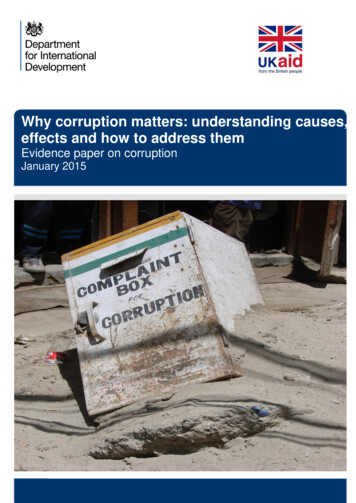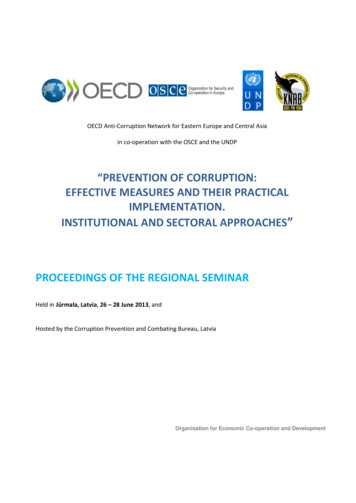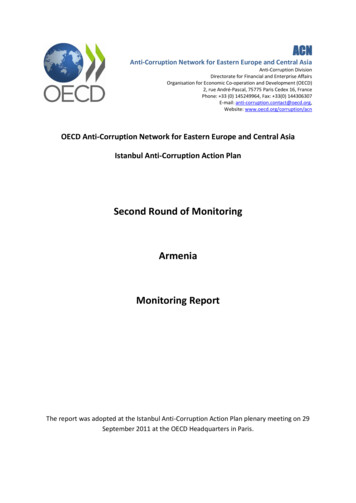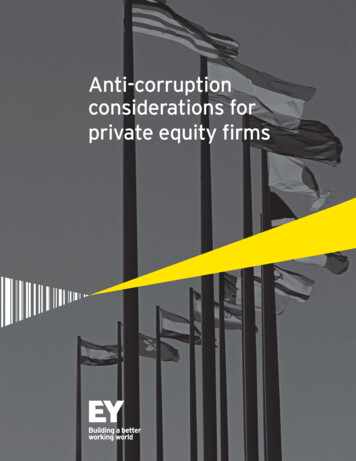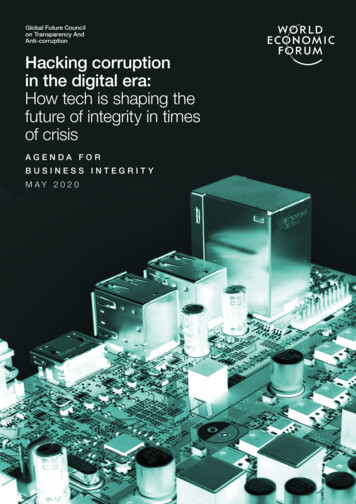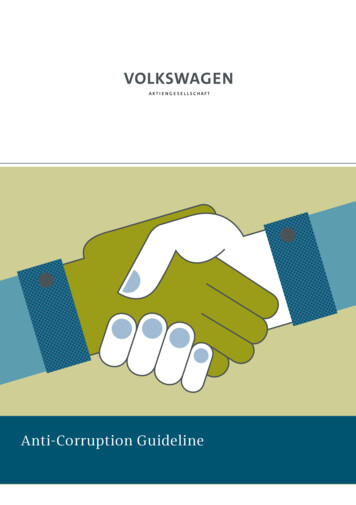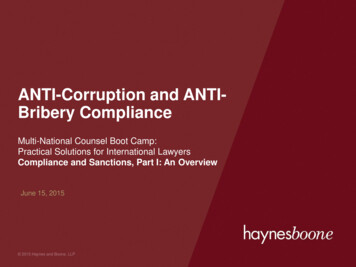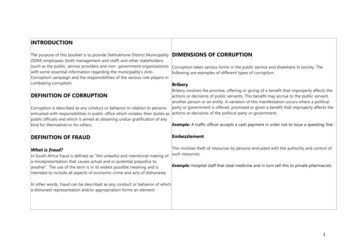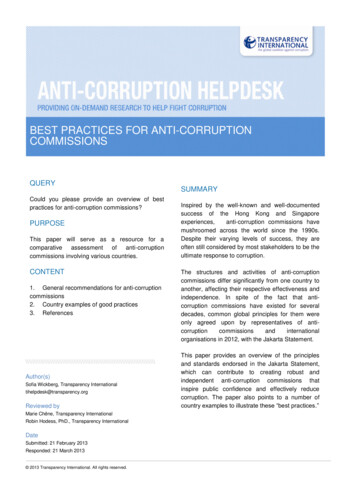
Transcription
BEST PRACTICES FOR ANTI-CORRUPTIONCOMMISSIONSQUERYCould you please provide an overview of bestpractices for anti-corruption commissions?PURPOSEThis paper will serve as a resource for acomparative assessment ofanti-corruptioncommissions involving various countries.CONTENT1. General recommendations for anti-corruptioncommissions2. Country examples of good practices3. ia Wickberg, Transparency Internationaltihelpdesk@transparency.orgReviewed byMarie Chêne, Transparency InternationalRobin Hodess, PhD., Transparency InternationalDateSubmitted: 21 February 2013Responded: 21 March 2013 2013 Transparency International. All rights reserved.SUMMARYInspired by the well-known and well-documentedsuccess of the Hong Kong and Singaporeexperiences,anti-corruption commissions havemushroomed across the world since the 1990s.Despite their varying levels of success, they areoften still considered by most stakeholders to be theultimate response to corruption.The structures and activities of anti-corruptioncommissions differ significantly from one country toanother, affecting their respective effectiveness andindependence. In spite of the fact that anticorruption commissions have existed for severaldecades, common global principles for them wereonly agreed upon by representatives of ions in 2012, with the Jakarta Statement.This paper provides an overview of the principlesand standards endorsed in the Jakarta Statement,which can contribute to creating robust andindependent anti-corruption commissions thatinspire public confidence and effectively reducecorruption. The paper also points to a number ofcountry examples to illustrate these “best practices.”
BEST PRACTICES FOR ANTI-CORRUPTION COMMISSIONS1. GENERAL RECOMMENDATIONSFORANTI-CORRUPTIONCOMMISSIONSA number of international conventions, both at globaland regional levels, establish the international legalframework in which anti-corruption commissionsoperate. There is agreement among internationallegal instruments, such as the United NationsConvention against Corruption (UNCAC), that statesought to establish a body (or several bodies) toprevent and combat corruption through lawenforcement. The international legal frameworkadvises that such institutions be independent,protected from undue influence and have adequatetraining and resources to undertake their duties. Anticorruption commissions or agencies (ACCs or ACAs)are one form of the above.The first anti-corruption commission was set up inSingapore in 1952, followed by Malaysia, Hong Kongand others. Asia has even been nicknamed the“cradle of ACAs” (De Jaegere 2012). The explosionof the number of anti-corruption commissionsworldwide happened later, in the 1990s; there arecurrently nearly 150 such entities throughout theworld. ACAs often emerge in a context of corruptionscandals, are formed through broad politicalconsensus and are regarded by most stakeholdersas the ultimate response to corruption (De Sousa2009a).ACCs or ACAs play a unique role in a country’sinstitutional framework, complementing the role oftraditional anti-corruption actors or law enforcementbodies. ACCs are publicly funded entities of adurable nature, whose specific mission is to fightcorruption and reduce the opportunities for it to occurin a country. It is the only entity mandated exclusivelyto combat corruption through a combination ofrepressive, preventive and educational measures (DeSousa 2009a). Anti-corruption commissions oftenwork closely with other state bodies, such as lawenforcement agencies, supreme audit institutions andministries of education, and usually have theresponsibility of the coordination of anti-corruptionefforts.Anti-corruption commissions are mandated differentlydepending on country contexts; in 2008 the OECDdeveloped a typology of the existing models: The multi-purpose agency represents the mostcommon model of a single-agency approach,combining the aspects of repression andprevention of corruption. This is the model onwhich are shaped the Hong Kong IndependentCommission against Corruption and theSingapore Corrupt Practices InvestigationBureau. The law enforcement agencies model eithercombines the three functions of detection,investigation and prosecution of corruptioncases, or specialises in detection/ investigation orprosecution. This model is the most common inWestern Europe. The preventive, policy development and coordination institutions focus more on corruptionrelated research, coordination of anti-corruptionpolicies and action plans, monitoring conflict ofinterest regulations, elaboration of codes ofconduct, facilitation of trainings, etc. This is amodel that can be found in France, India, Albaniaand Montenegro, for example.Despite their popularity, literature has becomeincreasingly sceptical about the effectiveness of anticorruption commissions (De Jaegere 2012). Theimpact of ACAs varies greatly from one context toanother due to a number of key factors that conditiontheir success, such as political will to effectively fightcorruption, public support for the cause and the ACA,etc. De Jaegere states that many ACAs havesuffered from their success, ending up failing theirduties because their zealous leadership aredismissed, imprisoned or forced to resign when theystart questioning the status quo.The challenges that anti-corruption agencies face areboth internal and external in nature. Some obstaclesare linked to poor institutional design, lack ofplanning and lack of efficient management andqualified staff, whereas other challenges have to dowith the environment in which these agenciesoperate, lack of political will, lack of public trust, etc.(De Sousa 2009a).2
BEST PRACTICES FOR ANTI-CORRUPTION COMMISSIONSThis paper lists some of the principles and standardsthat can contribute to creating solid anti-corruptioncommissions that inspire public trust and aresufficiently protected from external influences so thatthey can effectively reduce corruption.Common principles and standards foranti-corruption agenciesIn spite of the proliferation of anti-corruption agenciesin the last decades, common global principles andstandards were only developed and agreed upon tives from ACAs, from regional networks,1and other stakeholders, as well as a number ofinternational organisations met in Jakarta at theinvitation of the Corruption Eradication CommissionIndonesia (KPK), the UNDP and the UN Office onDrugs and Crime (UNODC). The participants cameup with a set of key requirements to ensure theindependence, both formal and operational, and theeffectiveness of anti-corruption agencies. Thefollowing draws on the 2012 Jakarta Statement, onthe 2008 European Partners against Corruption,“Common Standards and Best Practice for AntiCorruption Agencies” and on Samuel De Jaegere’s2012 “Principles for Anti-Corruption Agencies: AGame Changer.”“Principles for Anti-Corruption Agencies”, executiveorders or decrees are too easily annulled.Neutral appointment of ACA headsHeads of anti-corruption commissions should beappointed through a process that ensures her/hisindependence, impartiality, neutrality, integrity,apolitical stance and competence.A number of experts consider that the parliamentshould be involved in the recruitment of the heads ofACAs, which should ideally represent a consensusbetween the political majority and the opposition.Removal ofcontinuityACAheadsandleadershipIt is essential for the independence of anti-corruptioncommissions that their heads have security of tenureand can only be dismissed through a procedureestablished by law. These processes need to beclear and transparent.Experts tend to agree that a dismissal procedureinvolving only the judiciary and the executive powersis undesirable and that the parliament should have asay, through a two-thirds majority (IACC 2010).A broad and clear mandateACAs should have a clear mandate to tacklecorruption through prevention, education, awarenessraising, investigation and prosecution (see typologyabove). According to De Jaegere, an ACA shouldideally have the mandate of investigation, preventionand education, plus the ability to prosecute.If the ACA head were to be suspended, dismissed, toresign or retire, the authority of the ACA head shouldbe delegated by law to an appropriate official fromthe ACA, within a reasonable timeframe until theappointment of a new head. Such a mechanismavoids ACAs becoming paralysed in the absence of aleader.Legally guaranteed permanenceEthical conduct and governanceAnti-corruption commissions ought to be establishedby a proper and stable legal framework, such as aconstitution or in a special law, to ensure thepermanence of the institution. As De Jaegere says inACAs ought to adopt codes of conduct that set highstandards of ethical conduct for their employees andhave a solid compliance regime.1Such as the Network of National Anti-Corruption Institutions inWest Africa, the Southeast Asian Parties against Corruption, theArab Anti-Corruption and Integrity Network, the European Partnersagainst Corruption, etc.In a 2012 report on anti-corruption commissions,KPMG states that ACCs ought to maintain a“stringent governance framework” to ensure thatinvestigative units operate lawfully and follow due3
BEST PRACTICES FOR ANTI-CORRUPTION COMMISSIONSprocess.Adequate resources and financial independenceThe European Partners against Corruption point tothe importance of preserving the confidentiality ofinvestigations to protect the interests of all partiesinvolved (whistleblowers, suspects, witnesses, etc.).This includes mechanisms to protect whistleblowersand witnesses; secrecy of investigations, etc.ImmunityHeads and staff members of anti-corruptioncommissions should have immunity from civil andcriminal proceedings for acts committed as part ofthe exercise of their mandate, in order to protectthem from judicial manipulation and politicalinterference. Immunity should be lifted only underexceptional circumstances, such as a two-thirdsmajority vote in parliament.Adequate remuneration and ACA authority overhuman resourcesTo guarantee their effectiveness and independence,anti-corruption agencies should be able to set out thelevel of their salary scales themselves, and theemployees of ACAs should be remunerated at a levelthat allows for the employment of sufficiently qualifiedstaff. Working for an anti-corruption commission can,in some settings, present significant risks; thereforeACAs need to have control over the employmentconditions in order to be competitive on the jobmarket.Anti-corruption commissions should have the powerto recruit and dismiss their employees according totheir own internal procedures, provided that these areclear and transparent.ACA staff members are often part of the civil serviceand are thus subject to its rules and procedures.Experts highlight that civil service oversight bodiesshould have very limited control over recruitment forACA positions, or that their role should be balancedby the involvement of ACAs. Also, secondments fromother government units should be avoided in ordernot to challenge the anti-corruption commission’sindependence.To be able to perform their functions in an effectivemanner, anti-corruption agencies must be allocatedsufficient material and human resources. Theseobviously depend on the country’s budgetaryresources, but ACAs must receive timely, planned,reliable and adequate funding for gradual capacitydevelopment and improvement of the commission’soperations.The European Partners against Corruption state thatthe adequacy of resources can be assessed byqualitative indicators, such as regular increases inresources, stability of human resources, reliabilityand integrity of staff members, efficiency ofrecruitment procedures, etc. De Jaegere suggeststhat ACAs should have an annual budget guaranteeto avoid any arbitrary downsizing of the agency’sbudget.Anti-corruption commissions need to have fullmanagement rights and control over their budget,without prejudice to the appropriate accountingstandards and auditing requirements.Material resources include robust and appropriatesystems and technologies to be able to identify andprosecute corruption cases. These technologicaltools need to be advanced enough to match theincreasing sophistication of corruption and briberymethods; they range from email monitoring tofinancial surveillance and tracking (KMPG 2012).Collaboration and coordinationAnti-corruption commissions cannot work properly inisolation and should therefore foster good workingrelations with state agencies, civil society, the privatethsector, etc. At the 15 International Anti-CorruptionConference (IACC) in 2012, a special session on theeffectiveness of anti-corruption agencies pointed tothe issue of the political isolation of ACAs, which canlead to a lack of understanding and collaboration withother state institutions. Anti-corruption commissionsshould work as coordinating bodies of a country’snational anti-corruption efforts.4
BEST PRACTICES FOR ANTI-CORRUPTION COMMISSIONSThis includes international cooperation and mutuallegal assistance with other ACAs to jointly addresscorruption as a global issue, launch internationalinitiatives, exchange knowledge and experiences,and collaborate on a case-by-case basis.AccountabilityThe accountability of ACAs is crucial to ensure theircredibility and to build public trust. Anti-corruptioncommissions should have clear and standardoperating procedures, including monitoring anddisciplinary mechanisms, to reduce the risks ofmisconduct and abuse of power in the commissions.Anti-corruption commissions must strictly adhere tothe rule of law and be accountable to mechanismsestablished to prevent any abuse.The accountability of ACAs also requires regularreporting to the public. Some anti-corruptioncommissions report to the parliament, while othersreport to the Government or to an independentmonitoring body. It is essential that these reports areproduced at least once a year and are madeavailable to the public to justify efficiency andprogress, and strengthen citizens’ confidence in theanti-corruption agency. Public support is a strongcounter-power against potential attacks from thegovernment. Thus, fostering public supportcontributes to the sustainability of ACAs.For more information, please read:The Jakarta Statement on Principles for AntiCorruption Agencies ons and working documents, which allemphasise that the existence of an anti-corruptionbody should be established “as in accordance withthe fundamental principles of [the country’s] legalsystem.” (UNCAC). Therefore, none of the followingcountry examples perfectly aligns with theinternational standards. They are, however,considered “best practices” because of theireffectiveness in fighting corruption and due to thepublic confidence that they enjoy. Interestingly, eventhough they do not fully match the commonstandards, many recommendations can be identifiedin their structures.The following instances all correspond to the “singleagency three-pronged approach”, which bestillustrates the full range of activities that can beundertakenbyanti-corruptioncommissions.Moreover, a broad mandate allows ACAs not to relyon other law enforcement agencies to sanction thecorrupt (De Jaegere 2012). Because of their mandatethese agencies are also the most exposed to the riskof political interference and resistance.Hong Kong’s Independent Commissionagainst Corruption (ICAC)Hong Kong’s Independent Commission againstCorruption (ICAC) was one of the very first anticorruption commissions and has been identified as asuccess story and seen as a model to follow by manygovernments setting up anti-corruption commissions.There is, however, a growing consensus in theliterature that the Hong Kong experience is notreplicable, as it benefited from a unique set ofcircumstances and favourable conditions.Mandate, legal basis and accountability2. COUNTRY EXAMPLES OF BESTPRACTICESThe ICAC was set up by the IndependentCommission against Corruption Ordinance in 1974,with the mandate to undertake educational,preventive and investigative tasks, making HongKong’s ACA a multi-purpose agency. Theindependence of the ICAC is legally guaranteed bythe Constitution.Comparing anti-corruption commissions is not aneasy task since they operate in very differentcontexts and have not all existed for the same periodof time. ACAs ought to fit their national context, asHong Kong’s legal framework grants the ICAC thepowers of arrest, detention and granting bail, as wellas the powers of search and seizure, which includessearching bank accounts, seizing documents andThe EPAC Common Standards and Best Practicesfor Anti-Corruption Agencies (2008)5
BEST PRACTICES FOR ANTI-CORRUPTION COMMISSIONSrequiring suspects to provide details of their assets,income and expenditure. The ICAC has the powersto detain travel documents and restrain disposal ofproperty to prevent suspects from fleeing the country.It also has the right to protect confidentiality of aninvestigation.The ICAC reports to the head of government directlybut is, additionally, scrutinised by four independentadvisory committees composed of communityleaders or citizens appointed by the Chief Executive.According to the OECD, the ICAC has alwaysworked towards securing public confidence in thecredibility and effectiveness of the institution. Itproduces annual reports to justify activities andprogress, which are made available on the ICAC’swebsite, along with statistics regarding corruptionreports and prosecutions.The ICAC has adopted a code of ethics that itsemployees all pledge to uphold.Independence and resourcesHong Kong’s Independent Commission againstCorruption is one of the best funded anti-corruptioncommissions, with a budget of approximatelyUS 112 million in 2012. The ICAC is also very wellstaffed, with 1,300 permanent employees in 2012.The institution is in charge of the recruitment of itsown staff members. According to the OECD, theICAC is an attractive workplace that easily retains itsemployees thanks to strong public support for itswork. Staff members receive in-depth training fromthe very start and continuous training throughout theiremployment, on matters both job-specific and moregeneral(stressmanagement,personnelmanagement, etc.). The ICAC keeps pace withtechnology and provides ongoing IT training to staff(OECD 2008).The head of the ICAC is appointed by the ChiefExecutive of the Hong Kong Special AdministrativeRegion, who is also empowered to recommend thehead’s dismissal to the Central People’sGovernment. The mandate of the head of the ICAC isunlimited.AchievementsThe ICAC receives corruption complaints and isresponsible for analysing them and taking relevantcomplaints forward by launching an investigation,transferring the complaint to another relevantauthority etc. In recent years, the annual number ofcomplaints ranged from 3,500 to 4,500; in 2012, forexample, the ICAC received 3,932 corruptioncomplaints. The Operations Department is in chargeof the investigative tasks of the ICAC. In addition toinvestigating complaints it receives, the departmentuses proactive investigation methods to uncovercorruption cases. These methods include undercoveroperations and use of advanced technologies.The ICAC directs its investigations to the relevantauthorities, prosecutions being the responsibility ofthe Department of Justice. In 2012, 196 personswere prosecuted on corruption charges, 175 wereconvicted and 127 civil servants were recommendedfor administrative sanctions.The ICAC conducts hundreds of studies yearly tohelp the government identify institutional weaknessesand loopholes that create opportunities for corruption.It provides trainings to the public sector as well as tothe business community. The ICAC also partneredwith several youth organisations to educate youngergenerations about corruption and their rights.Indonesia’s Corruption EradicationCommission (KPK)Another commonly cited “best practice” example isIndonesia’s Corruption Eradication Commission(KPK). It is praised for having had exceptional resultsand reaching a “near to 100%” conviction rateagainst corrupt senior public officials, despite the lowgovernance environment in which this ACA wasestablished (Schütte 2012).Mandate, legal basis and accountabilityThe KPK was established by the 2002 Law (No. 30)on the Corruption Eradication Commission, whichguarantees its independence from all branches ofgovernment. Similar to Hong Kong’s ICAC, the KPKadopts a three-pronged strategy and is mandated toundertake investigative, preventive and monitoringtasks. Additionally, the KPK has the mandate toprosecute corruption cases and to take over casesbeing prosecuted by regular law enforcementagencies.6
BEST PRACTICES FOR ANTI-CORRUPTION COMMISSIONSThe Law on the Corruption Eradication Commissiongrants the KPK the authority to investigate andprosecute corruption cases, to request informationfrom government bodies in order to uncovercorruption, and to organise hearings and meetingswith relevant authorities. The KPK has the right toconduct surveillance, research and studies on publicsector institutions. It also has the right, as part of itsinvestigation and prosecution responsibilities, to tapcommunication lines and record conversations, toban individuals from leaving the country, to requestinformation from financial institutions, and to orderbanks to freeze assets and block accounts. The KPKcan conduct checks on the wealth of strations’managementsystems.TheIndonesian ACA has the right to conduct anticorruption education programmes and campaigns inorder to raise public awareness about the issue.The KPK is accountable to the public for its activities,effectiveness and integrity, and has an obligation toundergo regular audits, to publish annual reports andto make its documents accessible to the public. TheKPK also reports regularly to the Parliament, thePresident of the Republic and the State Auditor.The KPK had established an internal whistleblowermechanism and adopted a code of conduct.Independence and resourcesIndonesia’s anti-corruption commission is wellfunded. In 2010, the KPK had a budget of US 35.2million. Experts argue that, in terms of humanresources, the KPK is more about quality thanquantity (Bolongaita 2010); in 2010, the KPK had 650employees. The ACA is responsible for therecruitment of its staff, through open and transparentprocesses. Bolongaita indicates that the KPKcharges the recruitment tasks to a private HRmanagement firm to ensure full integrity andprofessionalism. Contrary to generally accepted bestpractice, KPK investigators and prosecutors oftencome from other government agencies, such as theMinistry of Finance. The recruitment process is highlyselective and candidates go through thoroughbackground checks as well as technical andpsychological tests (Bolongaita 2010).The KPK offers attractive and competitive salariescompared to other government agencies, andemployment in the anti-corruption agency is highlysought-after (Bolongaita 2010). The KPK has a wellfunctioningperformancemeasurementandevaluation system and financial rewards are basedon performance (Asian Human Rights Commission2009).The head of the KPK is chosen through a transparentselection process by which the Parliament nominatesand the President appoints, for a mandate of fouryears. Only the Parliament has the authority todismiss the head of the KPK.AchievementsAs stated above, Indonesia’s anti-corruptioncommission is known for its exceptional successrates, with a nearly 100 per cent conviction rateagainst corrupt officials. The KPK has investigatedand prosecuted officials from all levels of theadministration and has not retreated when faced withbig cases. Over the years it has charged more than40 members of Parliament, from all parties (DeJaegere 2012).According to its website, in 2011, the KPK handledmore than 20,000 complaints from citizens. In 2012,the anti-corruption commission investigated 48 casesand prosecuted 36, while 28 were still pending.The KPK is regularly threatened to be weakened andto see its mandate shrunk. In 2011, an attempt by thegovernment to amend the Anti-Graft Act would havereduced the legal penalties for corruption, threatenedthe protection of whistleblowers and undermined theconfiscation of stolen assets. In addition, therelationship between the KPK and Indonesia’s lawenforcement agencies have deteriorated since theKPK started to investigate police officers andprosecutors. The police launched an anti-KPKcampaign, in which many politicians and publicofficials have joined, depriving the commission ofnecessary resources and isolating it from other statebodies with which it needs to collaborate (ForeignPolicy 2012).Latvia’s Corruption Prevention andCombating Bureau (KNAB)In Latvia, efforts to set up an anti-corruptioncommission started in the mid-1990s, but concretesteps to establish an independent institution based7
BEST PRACTICES FOR ANTI-CORRUPTION COMMISSIONSon the three-pronged Hong Kong model only cameabout in the context of the negotiations aroundLatvia’s accession to the European Union. TheCorruption Prevention and Combating Bureau is nowseen as one of Europe’s most efficient anti-corruptioncommissions (De Jaegere 2012).Mandate, legal basis and accountabilityThe Corruption Prevention and Combating Bureauwas set up by the 2002 Law on CorruptionPrevention and Combating Bureau, prepared by aworking group comprised of various governmentbodies, such as the Financial Intelligence Unit, thePolice, the Prosecutor General’s Office, the Ministryof Justice, as well as Transparency InternationalLatvia. This law establishes the anti-corruptioncommission as an independent entity within Latvia’spublic administration.The KNAB’s activities include investigative,preventive and educational tasks. It coordinates thecountry’s anti-corruption programme, receives andanalyses citizens’ complaints, educates the public ontheir rights, suggests improvements to the legalframework, and disseminates information aboutcorruption. The KNAB has the powers to detect andinvestigate corruption-related offenses, to hold publicofficials administratively liable and to imposeadministrative sanctions.The anti-corruption commission in Latvia also plays asignificant role in overseeing political financing; it is incharge of controlling the implementation of relevantlaws. It has the authority to conduct investigationsrelated to violations of political financing regulationsand to request information from relevant entities,including financial and classified information. Politicalparties need to submit financial declarations andreports regularly to the KNAB. This institution is alsoin charge of overseeing disputed public procurementtenders.The KNAB is supervised by the Prime Minister butthe latter does not have the authority to impose anydecisions or orders to the commission. Aparliamentary committee working on corruptionissues oversees the work of the KNAB, playing aninformative and liaison role. The anti-corruptioncommission submits regular reports to the Parliamentand the Government and prepares activity andannual reports on preventive activities, detectedcriminal offences and administrative violations. Thesereports are made available to the public.Independence and resourcesIn 2011, the KNAB had a budget of approximatelyUS 2.5 million and 141 employees. Themanagement of the KNAB is responsible for therecruitment of staff members. KNAB officialsindicated to the European Partners againstCorruption that previous experience and reliability arethe main selection criteria and that many employeeshave previously worked with law enforcement or taxauthorities (EPAC 2008). Candidates to the highestpositions need to undergo a security clearance. TheKNAB provides many training opportunities to itsstaff, including procurement procedures, techniquesfor questioning suspects and witnesses, urelegislation, effective communication, etc. (OECD2008).The director of the KNAB is appointed by theParliament on recommendation of the Government,for a mandate of five years. The Parliament is theonly entity with the authority to revoke the head of theanti-corruption commission.AchievementsThanks to the KNAB’s efforts, between 2003 and2012, 166 individuals were found guilty of corruptionand were convicted (KNAB 2012). Experts state thatthe KNAB has been determined in investigatingcorruption cases at increasingly high levels of theadministration and in political parties (De Jaegere2012). The effectiveness of the KNAB is closelylinked to Latvia’s efficient prosecution andadjudication of corruption-related cases (OECD2008).The KNAB’s preventive and educational work is seenas proactive and comprehensive (De Jaegere 2012).The control of political financing is a key area of workof the anti-corruption commission. In 2011, more thanUS 400,000 was returned to the state budget bypolitical parties that had not correctly followedpolitical financing rules. Moreover, during the first halfof 2012, the KNAB imposed fines on 21 politicalparties. Control of public officials’ activities as well asconflict of interest prevention is another important8
BEST PRACTICES FOR ANTI-CORRUPTION COMMISSIONStask of the KNAB. In the first six months of 2012, theKNAB reviewed 88 cases, out of which 19 resulted infines and 69 in verbal warnings.3. REFERENCESAnti-Corruption Authorities. 2012. “Country ProfileHong Kong.” tion Authorities. 2010. “Country ProfileIndonesia.” tion Authorities. 2010. “Country ProfileLatvia.” http://www.acauthorities.org/country/lvBo
Reviewed by country examples to illustrate these "best practices Marie Chêne, Transparency International Robin Hodess, PhD., Transparency International Date Submitted: 21 February 2013 Responded: 21 March 2013 SUMMARY Inspired by the well-known and well-documented success of the Hong Kong and Singapore anti-corruption commissions have across the world since the 1990s. Despite their varying .
